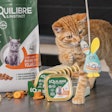
Shortly after I prognosticated on key pet food developments for 2021, I heard from someone who works for Moody’s debt-rating service covering the food sector, commenting that he was surprised I hadn’t included obesity as among the “rising pet health issues related to overfeeding during the pandemic.”
I understood his comment, having seen news coverage toward the end of 2020 about the pandemic apparently leading to pets putting on more pounds. For example, a December study conducted by Hill’s Pet Nutrition showed that more than 71% of pet professionals say the pandemic has affected how pets eat. Further, 33% of pet owners with an overweight pet said the dog or cat became overweight during the pandemic.
This is concerning, but the thing is, pet obesity is not a just recent phenomenon resulting from pet owners spending more time at home with their furry family members and indulging them with more foods and treats. Pet overweight and obesity, often stemming from overfeeding, has been rising for several years.
That was my response to the person who emailed me in reaction to my December blog post; yet the more I’ve thought about this, the more I’ve had to admit it was a miss on my part. No matter when or how it has come about, pet obesity has never received the attention it needs, not from pet owners or even some veterinarians or, frankly, much of the pet food industry.
Framing the pet obesity problem
The Association for Pet Obesity Prevention (APOP) typically conducts an annual survey to determine the rate of overweight and obesity among U.S. pets, as well as pet owners’ and veterinarians’ knowledge and perceptions. Due to the COVID-19 pandemic, the association was unable to do the survey in 2020.
Still, the 2019 report was telling: An estimated 60% of cats and 56% of dogs were overweight or obese in 2018, or 56 millions cats and 50 million dogs. The breakdown looked even worse, with nearly 26% of cats and 37% of dogs classified as overweight, while those deemed obese were almost 34% and 19%, respectively.
If pet overweight and obesity numbers continued to increase in 2019, as is likely, it seems the pandemic-driven lockdowns in 2020 only made the situation worse. In the Hill’s survey (conducted in partnership with Kelton Global), 53% of U.S. pet owners said they had been giving their pets treats for no reason, and that probably accelerated during the holiday season, as 64% admitted they spoiled their dogs or cats at that time. Accordingly, 60% of veterinarians surveyed said they anticipate seeing more overweight or obese pets this year.
This is not just a U.S. issue; it also happens in the U.K. and other developed pet food markets. Indeed, APOP has joined in a Global Pet Obesity Initiative Position Statement approved by 24 international veterinary professional organizations.
And, as with people, pet overweight and obesity can lead to multiple health problems. Nationwide Pet Insurance recently released data showing that insurance claims for conditions linked to or exacerbated by obesity rose for the ninth straight year in 2020, accounting for 20% of all the company’s claims and totaling more than US$90 million in veterinary expenses, according to a report by Pet Product News.
How to address pet obesity
Sources like Nationwide often recommend that owners with overweight or obese pets turn to their veterinarians for help and advice. Yet in APOP’s most recent survey, 68% of pet owners said they would like their veterinarians to recommend a routine or maintenance diet for their pets but only 38% reported their vets had done so; 22% said they had to ask and 40% received no dietary advice from their veterinarians.
Nationwide also suggests for owners to measure their pet’s food “accurately,” break up treats into even smaller portions, have pets hunt for their meals and set aside time for activity or play with their pets. (And pet owners should have plenty of time if they’re continuing to shelter at home.) But the responsibility shouldn’t fall on just veterinarians or pet owners.
The pet food industry can and should play a role. For example, pet food brands could do a lot more to help owners measure their pets’ food. I’ve heard from many experts in the industry that the now required calorie counts on all pet food labels haven’t really helped; and as the owner of a slightly chubby, older cat, I have to concur. There’s simply no reference point that makes sense to most owners.
As some in the industry have pointed out, it’s true that the nutrition facts labels and calorie information on human food—and pet food labels are increasingly being modeled after those, or at least efforts are under way in terms of nutrition facts on pet food—are not readily understood by consumers. But at least we’re familiar with them and can use them to compare products and look for certain nutrient amounts we know are better or worse for our health. That’s not yet the case with pet food.
Yet one of the core issues is also a key driver of the industry’s growth for at least 10 years now: superpremium, high-protein, nutrient-dense pet foods. The products are fine, of course, but pet food makers have not provided education about how to feed those foods at the same level as they’ve pushed their marketing claims. Namely that because of the nutrient and protein density, pets need much less of these foods; if the amounts aren’t carefully controlled, overweight or obesity results.
Of course, the rising popularity of pet treats probably contributes to the problem, too, along with feeding of table scraps and other human food, but in my mind, it all starts with pets’ main diets and the amounts they are fed.
So, is this the year the pet food industry helps tackle pet obesity more proactively?

















